07-11-2023 - Mechanical Drawing - Analysis of a tolerance [EN]-[IT]
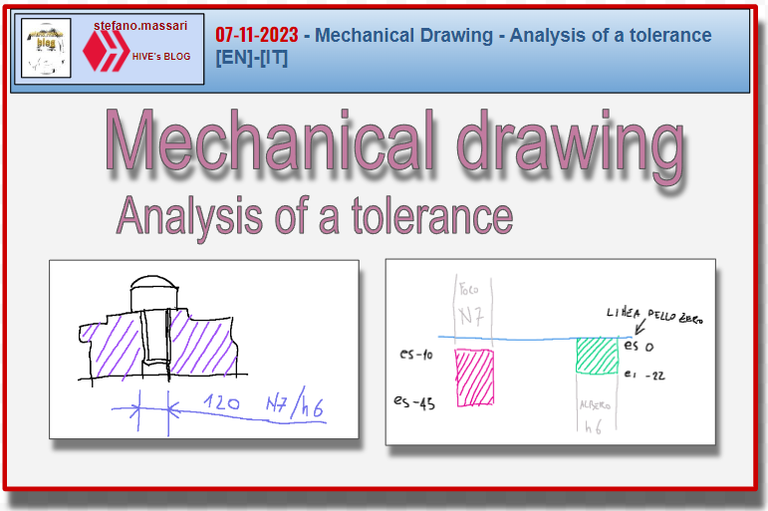
~~~ La versione in italiano inizia subito dopo la versione in inglese ~~~
ENGLISH
07-11-2023 - Mechanical Drawing - Analysis of a tolerance [EN]-[IT]
Dimensional tolerances
As regards the dimensional tolerances to be taken into consideration in the technical drawing, we must refer to the UNI EN 20286-1 - ISO system of tolerances and couplings. Fundamental principles for tolerances, deviations and fits.
To analyze tolerances we need three pieces of data:
- T = tolerance
- ei = Lower deviation
- es = upper deviation
We reiterate the concept of tolerance. Tolerance is defined as the dimensional variation, within two limits, of a certain piece in its construction to ensure correct functionality and ensure correct assembly.
The tolerance class of a hole is described by a large letter while the tolerance class of a shaft is described by a small letter.
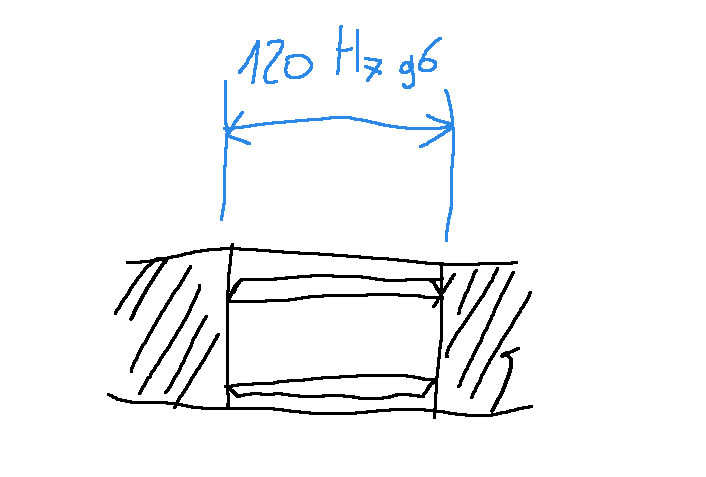
UNI EN 20286-1 standard
Below I leave the link to two PDFs where the various tables of the standard are shown.
https://itsmaker.it/wp-content/uploads/2017/11/Tolleranze_Dimensionali.pdf
https://www.edutecnica.it/meccanica/tolleranze/tolleranze.htm
Exercise
Given the following coupling (see drawing below)
let's try to identify the type of coupling, whether with play, with interference or uncertain.
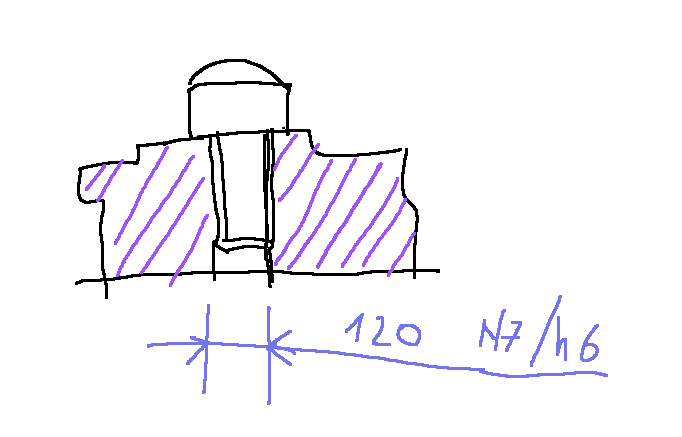
We first check the IT normalized values for a tolerance of 7 and for a tolerance of 6.
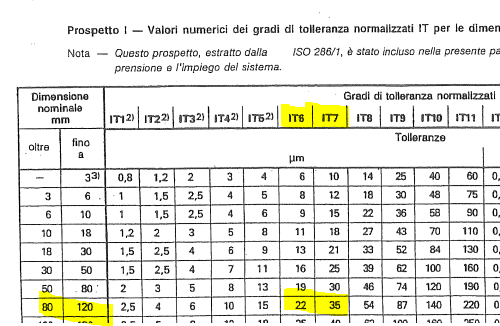
Degrees of tolerance
(shaft) tolerance width IT6=22 μ
(hole) tolerance width IT7=35 μ
Lower bounds - Deviation indices
ei = Tolerance h for a 120 shaft is 0 from the ZERO line
ei = The N tolerance for a 120 hole starts from -10 μ from the ZERO line
Note:
To check the N tolerance data you can also go to this site
https://www.ilcalibro.it/n7.htm
Table II for trees
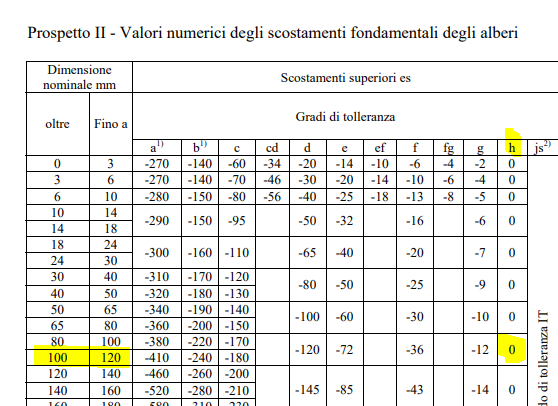
Table III for holes
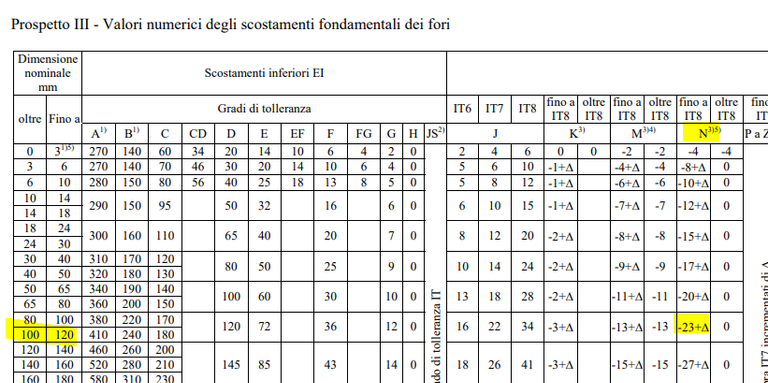
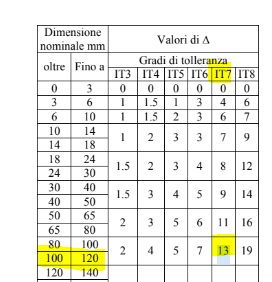
Calculation of shaft tolerances in h6
– From Table II it follows that for the tolerance class h the position of the lower limit (ei) is 0 μ.
Given the width and position of the lower bound, it is possible to calculate the position of the upper bound (es) as follows:
es = ei + IT = 0 μ + 22 μ = 22 μ
Calculation of hole tolerances in N7
– From Table II it follows that for the tolerance class h the position of the lower limit (ei) is 0 μ.
Given the width and position of the lower bound, it is possible to calculate the position of the upper bound (es) as follows:
es = ei + IT = -10 μ + (-35) μ = -45 μ

We can deduce that we are faced with an uncertain pairing.
Maximum clearance 12 μ
Maximum interference 45 μ
Conclusions
When choosing the dimensional tolerances it is important to understand well which of the three natures the coupling must have: with play, with interference or uncertain

ITALIAN
07-11-2023 - Mechanical Drawing - Analisi di una tolleranza [EN]-[IT]
Tolleranze dimensionali
Per quanto riguarda le tolleranze dimensionali da tenere in considerazione nell'ambito del disegno tecnico dobbiamo fare riferimento alla norma UNI EN 20286-1 - Sistema ISO di tolleranze ed accoppiamenti. Principi fondamentali per tolleranze, scostamenti ed accoppiamenti.
Per analizzare le tolleranze abbiamo bisogno di tre dati:
- T = tolleranza
- ei = Scostamento inferiore
- es = scostamento superiore
Ribadiamo il concetto di tolleranza. Si definisce tolleranza la variazione dimensionale, all’interno di due limiti, di un certo pezzo nella sua costruzione per assicurarne una funzionalità corretta ed assicurarsi il corretto montaggio.
La classe di tolleranza di un foro è descritta da una lettera grande mentre la classe di tolleranza di un albero è descritta una lettera piccola.

Norma UNI EN 20286-1
Qui di seguito lascio il link di due PDF dove sono riportati i vari prospetti della norma.
https://itsmaker.it/wp-content/uploads/2017/11/Tolleranze_Dimensionali.pdf
https://www.edutecnica.it/meccanica/tolleranze/tolleranze.htm
Esercizio
Dato il seguente accoppiamento (vedi disegno qui sotto riportato)
proviamo ad individuare il tipo di accoppiamento, se con giuoco, con interferenza o incerto.

Per prima cosa verifichiamo i valori normalizzati IT per una tolleranza 7 e per una tolleranza 6.

Gradi di tolleranza
(albero) ampiezza di tolleranza IT6=22 μ
(foro) ampiezza di tolleranza IT7=35 μ
Estremi inferiori - Indici degli scostamenti
ei = La tolleranza h per un albero da 120 è di 0 dalla linea dello ZERO
ei = La tolleranza N per un foro da 120 parte da -10 μ dalla linea dello ZERO
Nota:
Per verificare i dati della tolleranza N si può andare anche in questo sito
https://www.ilcalibro.it/n7.htm
Prospetto II per alberi

Prospetto III per fori


Calcolo tolleranze dell'albero in h6
– Dal Prospetto II segue che per la classe di tolleranza h la posizione dell’estremo inferiore (ei) è 0 μ.
Data l’ampiezza e la posizione dell’estremo inferiore, è possibile calcolare la posizione dell’estremo superiore (es) come segue:
es = ei + IT = 0 μ + 22 μ = 22 μ
Calcolo tolleranze del foro in N7
– Dal Prospetto II segue che per la classe di tolleranza h la posizione dell’estremo inferiore (ei) è 0 μ.
Data l’ampiezza e la posizione dell’estremo inferiore, è possibile calcolare la posizione dell’estremo superiore (es) come segue:
es = ei + IT = -10 μ + (-35) μ = -45 μ

Possiamo dedurre che siamo di fronte ad un accoppiamento incerto.
Gioco massimo 12 μ
Interferenza massima 45 μ
Conclusioni
Quando si scelgono le tolleranze dimensionali è importante capire bene quali delle tre nature deve avere l'accoppiamento: con gioco, con interferenza o incerto
THE END
Thanks for the class
Nice one!
The calculation of tolerances, especially of the upper and lower extremes, may seem complicated, but if it is explained well it is actually quite simple. The problem of understanding these topics well lies in how they are told or explained
Yay! 🤗
Your content has been boosted with Ecency Points, by @c3r34lk1ll3r.
Use Ecency daily to boost your growth on platform!
Support Ecency
Vote for new Proposal
Delegate HP and earn more
Sicuramente, in fase di progettazione, è molto importante tenere conto se il pezzo o il meccanismo necessitano di aggiustamenti dovuti ad interferenze o incendio, che sono i più comuni, questo dipenderà dall'applicazione, ad esempio per un cuscinetto abbiamo bisogno di tolleranze 0.0 e nel caso di un pistone sono necessarie tolleranze con il fuoco
Vedo che conosci la questione in maniera approfindita, sei coinvolto in queste cose anche per questioni quitidiane o di lavoro?
Quando vado dal meccanico per ordinare un pezzo, a volte devo aspettare, ascolto i discorsi del meccanico e imparo hahahah, non sono ficcanaso, non c'è altro da fare :)